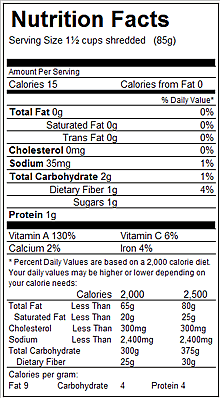Contents:
Common Names | Parts Usually Used | Plant(s) & Culture | Where Found | Medicinal Properties
Uses | Formulas or Dosages | Nutrient Content | Bibliography
Scientific Names

- Lactuca sativa L.
- Compositae
- Composite family
Common Names
- Garden lettuce
Parts Usually Used
Juice, leaves
Back to Top
Description of Plant(s) and Culture
Everyone is familiar with common lettuce as it is available in the supermarket, but this is the plant picked before it is fully grown. When allowed to mature, lettuce develops a tall stem with alternate leaves and panicled heads of yellow flowers. Flowering time is June to August.
Other varieties: Poison lettuce (L. virosa)(also known as “the poor man’s opium); Wild lettuce (L. canadensis); Prickly lettuce (L. scariola); another type of Wild lettuce (L. biennis)
Back to Top
Where Found
Cultivated
Back to Top
Medicinal Properties
Anodyne, antispasmodic, expectorant, sedative
Back to Top
Uses
When allowed to go to seed, garden lettuce and several other varieties contain a milky juice that has narcotic effects. In common lettuce, it is a harmless substance which can be used as a calming agent for insomnia and various nervous conditions, coughs, asthma, and cramps. Although salad lettuce is picked before the juice develops, eating a few leaves before bedtime may be helpful for insomnia. A decoction of the leaves makes a good skin wash. The juice of lettuce mixed or boiled with Oil of Roses, applied to the forehead and temples eases headaches. Being eaten boiled, it helps digestion, quenches thirst, increases milk in nursing mothers, eases griping pains in the bowels.
Culpeper states that lettuce is forbidden to those that are short-winded, or have any imperfection in the lungs, or spit blood.
Back to Top
Formulas or Dosages
Since lettuce loses its medicinal value rapidly after being picked, use it as fresh as possible.
Back to Top
Nutrient Content
Chlorine, potassium, calcium, iron, vitamins B2, C, E, and K.

Bibliography
![]() The Complete Medicinal Herbal
The Complete Medicinal Herbal, by Penelope Ody, Dorling Kindersley, Inc, 232 Madison Avenue, New York, NY 10016, First American Edition, copyright 1993
![]() Culpeper’s Complete Herbal & English Physician: Updated With 117 Modern Herbs
Culpeper’s Complete Herbal & English Physician: Updated With 117 Modern Herbs, by Nicholas Culpeper, Meyerbooks, publisher, PO Box 427, Glenwood, Illinois 60425, 1990, (reprint of 1814)
![]() Eastern/Central Medicinal Plants
Eastern/Central Medicinal Plants, by Steven Foster and James A. Duke., Houghton Mifflin Company, 215 Park Avenue South, New York, NY 10000
![]() The Herb Book
The Herb Book, by John Lust, Bantam Books, 666 Fifth Avenue, New York, NY. copyright 1974.
 How Indians Use Wild Plants for Food, Medicine & Crafts
How Indians Use Wild Plants for Food, Medicine & Crafts, by Frances Densmore, Dover Publications, Inc., 180 Varick Street, New York, NY 10014, first printed by the United States Government Printing Office, Washington, in 1928, this Dover edition 1974
 The Magic of Herbs in Daily Living
The Magic of Herbs in Daily Living, by Richard Lucas, Parker Publishing Co. (1988).
![]() The Nature Doctor: A Manual of Traditional and Complementary Medicine
The Nature Doctor: A Manual of Traditional and Complementary Medicine, by Dr. H.C.A. Vogel; Keats Publishing, Inc., 27 Pine Street (Box 876) New Canaan, CT. 06840-0876. Copyright Verlag A. Vogel, Teufen (AR) Switzerland 1952, 1991
![]() Webster’s New World Dictionary
Webster’s New World Dictionary, Third College Edition, Victoria Neufeldt, Editor in Chief, New World Dictionaries: A Division of Simon & Schuster, Inc., 15 Columbus Circle, New York, NY 10023
